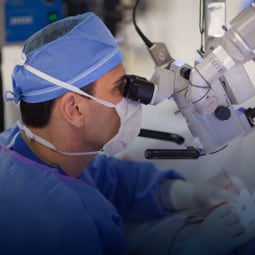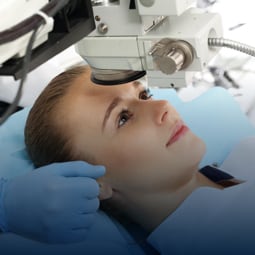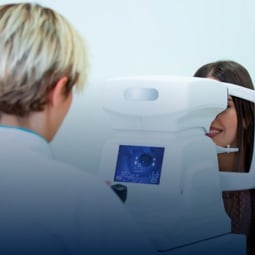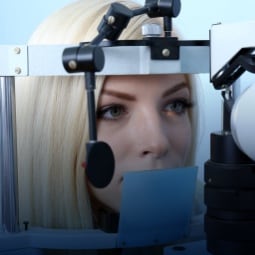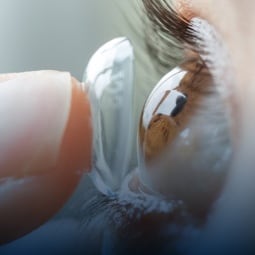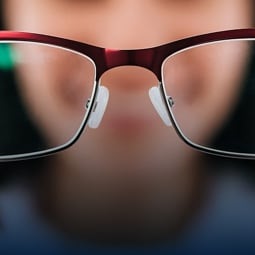
Achieve Clearer Vision
Our team has been improving the lives of our patients with procedures like LASIK for over 30 years. We are pleased to offer many of the latest refractive surgical procedures, including LASIK, Photorefractive keratectomy (PRK), clear lens enhancement (CLE), intra-corneal implants, and implantable contact lenses (ICL).
Your vision goals are unique–during a consultation, our ophthalmologists can assess your vision and get to know your individual needs and preferences before building you a treatment plan. Book an appointment at one of our Southwest Florida locations to see firsthand the difference LASIK can make in your life.


What Is LASIK?
LASIK, or laser-assisted in-situ keratomileusis, is the most common type of laser eye surgery performed. In this procedure, your surgeon will precisely remove corneal tissue using a laser to reshape the cornea, changing its focusing power. At Center For Sight, we use a combination of laser technology to perform blade-free LASIK with micron-level precision and accuracy.

How LASIK Works
The LASIK procedure involves 2 steps. First, your surgeon will make a flap using the IntraLase laser, and then they will reshape the cornea with the WaveLight EX500 excimer laser. Together, this technology allows us to provide each patient with a customized and precise laser treatment for the eyes.
Advantages of Blade-Free LASIK
There are several advantages to LASIK eye surgery, including:
- Improved safety
- Better vision
- The highest degree of predictability
- Reduced dry eye symptoms
- Individualized flaps
Photorefractive keratectomy (PRK)
Another laser eye surgery we perform is Photorefractive keratectomy (or PRK). This surgery is similar to LASIK, but instead of reshaping the cornea through a flap, we reshape the cornea directly on the surface.
With PRK, we reshape the cornea with help from the WaveLight EX500 excimer laser after removing the outer layer of the cornea (epithelium). We’ll then bandage your eye to protect it throughout the healing process, which tends to be slightly longer compared to LASIK.
Implantable Contact Lens
An implantable contact lens (ICL) is a lens placed inside of the eye. This procedure can provide you with many benefits, including:
- Your natural lens does not need to be removed when placing the ICL
- The lens tucks behind the iris, providing clearer vision
- An ICL can be removed and replaced if your refractive error changes with time

What is the EVO ICl Lens?
EVO Visian ICL is an Implantable Collamer™ Lens that corrects common vision problems such as nearsightedness (myopia) and astigmatism. Collamer is a biocompatible material that works in harmony with the eye. The lens, which is slightly smaller than a typical contact lens, is implanted in the eye during a 20 to 30 minute procedure. Unlike laser vision correction surgeries that permanently change the shape of your cornea, the EVO Visian ICL procedure is additive, meaning that no corneal tissue is removed. Worldwide, more than 1 million EVO Visian ICL lenses have been implanted.
What are the Benefits of EVO Visian ICL?
EVO Visian ICL offers many benefits for patients who are candidates for the ICL procedure and are seeking a vision solution that allows them the freedom of less dependence on glasses or contact lenses. The advantages of EVO Visian ICL include:
- Sharp, clear vision
- Excellent night vision
- Does not cause dry eye syndrome
- Quick procedure and recovery
- No removal of corneal tissue
- Removable by your doctor
- Protection from UV Rays

Who is a Candidate for Vision Correction with EVO Visian ICL?
People who want a flexible and biocompatible vision correction option, as well as many patients who are not candidates for laser vision correction, find that Visian EVO ICL is the right procedure for them.
Ideal candidates for EVO Visian ICL:
- Are between the ages of 21 and 45
- Are seeking a vision correction solution for moderate to severe nearsightedness (with or without astigmatism)
- Have a stable prescription that has not changed within the last year
- Have good ocular health with no history of glaucoma, iritis, or diabetic eye disease
How is the EVO Visian ICL Lens Procedure Performed?
Vision correction with the EVO Visian ICL is an outpatient procedure that typically takes 20 to 30 minutes. After an initial exam with your ophthalmologist to determine that the EVO ICL is right for you, you will schedule your procedure. On the day of the procedure, your eyes will be numbed with an anesthetic eye drop and your refractive surgeon will implant the ICL between the iris (colored part of the eye) and the natural lens. Your surgeon will likely schedule a follow-up appointment the same day as the procedure.
Can the EVO Visian ICL Lens be Removed?
Yes, the EVO Visian ICL is intended to provide permanent vision correction, but it can be removed or upgraded by your surgeon.
Will I be able to feel the EVO Visian ICL Lens?
No, patients should not feel the lens as it does not adhere to any structures within the eye and does not move once in place.
Will other people be able to see the EVO Visian ICL Lens?
No, the Visian EVO lens is placed behind your iris where only your eye doctor will be able to detect it.
Are there any risks with the EVO Visian ICL Procedure?
Any medical procedure has certain risks associated with it. Potential complications of the EVO ICL procedure, although rare, include inflammation, an increase in eye pressure, or the need for an additional procedure, like an ICL exchange. While these potential risks are mitigated as much as possible, they can all typically be addressed early and without long-term side effects.
Book Your Consultation
At Center For Sight, we can help improve your vision. Our experienced doctors and medical team can help you find the right vision correction method for you, giving you clearer vision while lowering your dependence on glasses. Book a consultation today to see how we can help.

Our Locations
See Our Google Reviews

News
Revolutionizing Vision Correction: The Science Behind Light Adjustable Lenses
Cataracts, Light Adjustable LensesThe field of ophthalmology has made breakthroughs with the Light Adjustable Lens (LAL) from RxSight, changing the nature of post-cataract surgery vision correction. This innovative technology is exclusively produced by Center For Sight and is the only option for this technology available on the market. The premium lens allows precision adjustments to vision after surgery. […]
Read More… from Revolutionizing Vision Correction: The Science Behind Light Adjustable Lenses
Safeguarding your eyes during the solar eclipse
News & UpdatesAre you ready for the upcoming solar eclipse? While this celestial event promises to be a stunning sight, it’s essential to prioritize eye safety to avoid potential harm to your vision. Center For Sight’s Vitreo-Retinal Surgeon, Dr. Tanuj Banker would like to share some crucial tips to help you protect your eyes during the eclipse. […]
Read More… from Safeguarding your eyes during the solar eclipse
Cornea Treatment and Nutrition: Foods That Promote Eye Health
Cornea CareMore than ever, people recognize the link between what they eat and how they feel overall. At Center For Sight SW FL, we believe that nurturing good life habits can directly affect eye health. Our licensed ophthalmologists often hear the question, “What foods can I eat to better my eyesight?” from curious patients. It’s encouraging […]
Read More… from Cornea Treatment and Nutrition: Foods That Promote Eye Health
Revolutionizing Vision Correction: The Science Behind Light Adjustable Lenses

The field of ophthalmology has made breakthroughs with the Light Adjustable Lens (LAL) from RxSight, changing the nature of post-cataract surgery vision correction. This innovative technology is exclusively produced by Center For Sight and is the only option for this technology available on the market. The premium lens allows precision adjustments to vision after surgery. […]
Read More… from Revolutionizing Vision Correction: The Science Behind Light Adjustable Lenses
Safeguarding your eyes during the solar eclipse

Are you ready for the upcoming solar eclipse? While this celestial event promises to be a stunning sight, it’s essential to prioritize eye safety to avoid potential harm to your vision. Center For Sight’s Vitreo-Retinal Surgeon, Dr. Tanuj Banker would like to share some crucial tips to help you protect your eyes during the eclipse. […]
Read More… from Safeguarding your eyes during the solar eclipse
Cornea Treatment and Nutrition: Foods That Promote Eye Health

More than ever, people recognize the link between what they eat and how they feel overall. At Center For Sight SW FL, we believe that nurturing good life habits can directly affect eye health. Our licensed ophthalmologists often hear the question, “What foods can I eat to better my eyesight?” from curious patients. It’s encouraging […]
Read More… from Cornea Treatment and Nutrition: Foods That Promote Eye Health
Check Us Out On Facebook


We are a proud partner of US Eye, a leading group of patient-centric, vertically integrated multi-specialty physician practices providing patients with care in ophthalmology, optometry, dermatology, audiology and cosmetic facial surgery.




